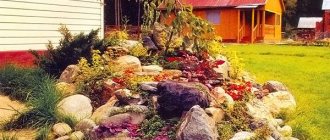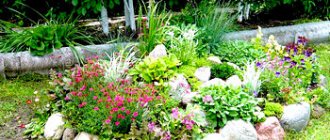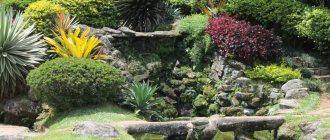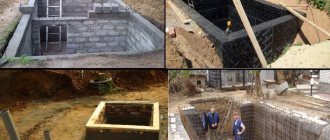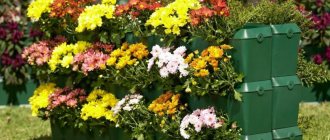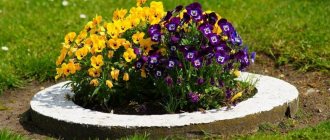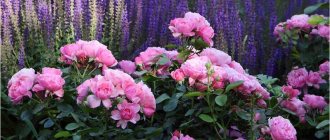- DIY Alpine slide
- Choosing a location for an alpine slide
- What time of year can you build a rock garden?
- Basic rules for arranging a rock garden
- Do-it-yourself Alpine slide: step-by-step instructions with photo illustrations
- Drainage and soil for an alpine slide
- Selection of stones for an alpine slide
- What plants are needed for an alpine slide: nuances of choosing colors
- Schemes for plant placement on an alpine hill
DIY Alpine slide
In an effort to transform the garden and create an original landscape, pay attention to a unique and memorable element of landscape design - an alpine slide . Inheriting the landscape of real rocky mountains, one cannot deprive the rock garden of such a natural decoration as mountain flora. Properly selected plants will help create the most natural look. photos with design recommendations will help you create a real mountain corner on your site.
Rockery with stones: instructions for creating a stone slide (read more)
A rock garden is a beautiful landscape composition of stones and flowers.
Step-by-step photo instructions with design recommendations and the names of plants for an alpine hill will help you understand some of the intricacies of landscaping and create an original and very beautiful corner on your summer cottage or against the background of the facade of a country house.
Varieties
Rock gardens differ in their relief; before starting to create a picturesque area, you need to take into account the landscape features of the local area or park area.
| View | Peculiarities | Recommendations | |
| 1 | mountain wall | Used in the construction of terraced slopes. Flowers and creeping junipers are planted in niches and recesses left in the stonework and filled with soil. | After creation, the wall is watered generously from a spray bottle until the plants take root. |
| 2 | rocky hill | Small stones are placed at the base of the embankment, the top is created from large fragments, and alpine plants are planted | A slide of boulders and layered stones is combined with paved paths and lawns |
| 3 | Gorge in the mountains | In a small ditch or hollow, stones of different heights are laid out along the slopes, and plants are planted between them. | The landscape composition is suitable for areas with natural ravine terrain and two slopes. To strengthen the ravine, boulders are dug into the ground |
| 4 | mountain valley | Stones are buried three-quarters of the way into the ground, paths are laid, a grass carpet is created, and shrubs are planted. | An abundance of herbs and flowers can be complemented by a fountain or small pond |
| 5 | rock cliff | They recreate the breaks in the mountainous terrain with the help of stone fragments, the cliff is planted with crassula, creeping plants | Work begins at the base of the slope, the boulders are pressed tightly together |
| 6 | Mountain Creek | The bottom of the stream is covered with river stones, pellets are laid along the banks, and moisture-loving plants are planted. | Ferns with wide feathery leaves planted near a stream create the effect of wild nature. |
| 7 | Alpine garden | The garden is laid out on an inclined or flat surface, using a minimum of stones | The emphasis is on shrubs and bright plants |
| 8 | Japanese motives | They create the appearance of a collapsed rock, the picturesque area is decorated with basalt, tuff, the area at the base is decorated with perlite, fine gravel | The style of plants in gray, yellow-brown shades, muted red colors, and dwarf shrubs of asymmetrical shape are emphasized |
| 9 | Mini rock garden | A hole in a large trunk, a ceramic container, a basin are filled with earth, small stones, sedums, grains, and armeria are planted | Pre-make water drainage and drainage |
Choosing a location for an alpine slide
A rock garden or alpine slide is a small piece of wild nature located in a garden or on a plot. For such a masterpiece you need to choose a place that can be viewed from all sides. A developed rock garden requires sunlight, so you need to allocate a part of the garden for it, located away from existing buildings and large trees with a developed crown.
It is better to arrange an alpine hill on the south side of the site.
It is good if the slide is located on the south side, near the recreation area. This arrangement will allow you to get optimal lighting, and you will be able to admire the beauty of wild plants and rocky stones much more often. Also, when choosing a place for a decorative flower bed, you need to pay attention to the quality of the soil. It is much easier to set up a rock garden on sandstones, but if the soil is clayey, then additional work will be required to create drainage.
The rock garden is located on the slope of the site.
Selecting a location
The rock garden on the site is a central element that should be clearly visible and in harmony with garden paths and other decorative details. It is unacceptable to have greenhouses, garden beds, or outbuildings near the picturesque area. The most successful places for landscape composition are lawns, slopes, hollows, small hills that are located near recreation areas and are isolated from the wind. Areas with high groundwater levels have a negative impact on plants and the stability of stone structures. To remove moisture, create a drainage pond that will drain the water and complement the stone flower garden. Alpine flora is photophilous; it is advisable to locate the mountainous fragment on the eastern or southeastern side, where there are no shading trees. For a partially darkened area, you will have to select appropriate vegetation. To prevent the rock garden from losing its attractiveness, watering facilities should be located nearby.
What time of year can you build a rock garden?
When arranging an alpine hill, the scope of work is such that it practically does not depend on the time of year. It’s just not worth doing this in winter due to weather conditions. But the best option is still considered to be early autumn, when amateur gardeners have free time between harvesting and cleaning the site for the winter.
Alpine slide using small and large stones.
It is worth knowing that the rock garden takes several months to naturally shrink. After which all errors that were previously invisible will be noticeable. Before planting, these shortcomings should be eliminated. If the planting of flora representatives is planned for the fall, preparations begin in the spring. There are several basic rules for creating an alpine slide with your own hands. A step-by-step photo gallery demonstrates the intricacies of this process.
The rock garden is a decoration of a suburban area.
Care
A planted alpine hill needs less attention than a regular garden or flower bed, which is ideal for amateur gardeners with limited time resources. Weed infestation is usually prevented by placing gravel around the mound and using non-greasy soils. Or they are promptly deleted.
Various infections, bacterial infections, rot, which are caused by high humidity, are prevented by sufficiently good drainage. Also, rock gardens rarely need fertilizing and fertilizers, and mountain plants rarely need to be pruned due to their very slow growth. However, very eroded soil should be replaced.
Watering is only necessary during the particularly hot, dry summer months. Seeds of other plants should be regularly prevented from getting onto the hill and their further settlement in the rock garden. Because mountain plants grow slowly, they are quickly overwhelmed by other, more active crops.
A real gem of the garden
Various slugs, snails and other pests must also be strictly removed. Mosses must be dealt with in the same way. After removal, loosening the soil with sand or limestone helps against them.
An alpine slide with natural stones is suitable for both large and small gardens. Rolling hills look especially beautiful, and low, colorful carpets of plants will look great among dwarf conifers. A pond or stream can also be combined into a common composition with a rock garden. But they must be of appropriate sizes. Remember that in rock gardens, paths or places where you can walk are laid with flat stones or fine gravel. Driftwood or other decorative objects can add variety and set the necessary accents.
Amazing decoration in front of the house facade
You can also place containers or pots of seasonal plants on flat rocks. Depending on the differences in the flowering season of trees and grasses. Of course, the shape and size of the stones are primarily important for an alpine slide. However, in everything you should observe moderation and adhere to style. Take an example from nature.
Basic rules for arranging a rock garden
Before planting flowers, it is necessary to prepare an appropriate high-quality foundation. When creating a rock garden, the following steps are followed:
- Assess the size of the plot and compare your desires with the possibilities. Most plants for alpine hills love light, so it is advisable to choose a well-lit place, possibly with some shading. Areas with changes in relief are perfect;
- take care of quality drainage. Mountain plants generally do not like stagnant water, but prefer dry soil;
- select stones and determine the general appearance of the composition. If you have problems with this, use ready-made photos of the landscape design of an alpine hill with your own hands. Do not forget about the properties of certain types of stones to leach and oxidize the soil. This knowledge will be useful for the correct selection of plants and will protect them from death;
- Fill soil between the stones. Plants for rock gardens are most often unpretentious, but some like fertilized soil;
- let the whole composition settle for several weeks, or better yet, the winter period. After this, begin the process of populating it with representatives of the flora.
Landscape masters have developed plans and diagrams according to which the rock garden is arranged. They take into account all the subtleties and nuances that help determine the location of the flowerbed and the order of planting.
Scheme of planting plants on an alpine hill.
Provided that the alpine slide will be viewed from any side, a pyramidal shape with the highest point in the center is best suited. There is no point in maintaining symmetry when arranging a piece of wild nature. The composition will look more original if all the elements are arranged abstractly. If you plan to locate the rock garden on an existing slope, then parts of the structure can be located on the same level.
Rock garden with bright flowers.
The height of the rock garden should correspond to its area. For every meter of diameter of the future club, it is worthwhile to provide for a rise of approximately 0.2 m; accordingly, an alpine slide with a diameter of about 4 meters should be at least 80 cm in height. Step-by-step photos of DIY alpine slides are presented below.
Large stones were used in the construction of the alpine slide.
Step-by-step instructions of 8 steps
An approximate step-by-step instruction for creating a rock garden on your site is as follows:
- Select the area where the slide will be located.
- Make sketches of the diagram, taking into account all the points - including colors.
- Draw the outline of the area and remove the turf.
- Fill the area with a drainage layer.
- Fill the area with fertile soil.
- Place the core of the hill and add soil.
- Plant the plants.
- Apply the finishing touches.
Let's look at some of the steps in more detail so that the reader has a correct idea of how to create an alpine slide with your own hands.
See alsoHow to decorate a summer cottage
Drawing a plan for an alpine slide
It is important to draw on paper what the finished composition will look like. Use a schematic sketch to indicate where the flowers and stones will be located.
See alsoHow to decorate the yard with your own hands
Choosing a place
It is desirable that the flowerbed is located in a sunny place and is clearly visible from all sides. It is not advisable to place it near a house or other buildings, since the composition may be damaged by melting snow.
Choosing the right place for a hill is an important point in landscape design
The rock garden looks great on uneven surfaces created by nature.
Removing the turf
The territory can be marked using pegs with ropes. The turf is removed to a depth of 30 cm and set aside. Don't forget to get rid of the weeds. You need to carefully look through the ground and remove the remains of all the roots.
Preparing the base
At the bottom of the pit we lay out gravel or crushed stone about 15 cm, and then another 5-10 cm of sand. For maximum density, fill the base with water.
Setting the stage
The soil is made from turf obtained from a dug pit, peat, humus and sand.
The exact composition is selected depending on the varieties of plants that will be planted in a given area.
Important! Remember that different plants like different types of soil. When creating a rock garden with your own hands, this must be taken into account.
We're building a slide
Along the perimeter, the largest stones are placed in the bottom layer, and the middle is covered with earth. Then the middle elements are laid out on them, and the voids are again filled with soil. The smallest natural materials are placed at the very top.
Planting plants
Let's get to the fun part - planting flowers.
They should match in color and not overlap each other. Planting starts at the top and gradually goes down. At the final stage, water the flowers and wash off the dirt from the stones.
Adding the finishing touches
At the last stage, we fill the gaps with pebbles and, if desired, install garden lights.
Do-it-yourself Alpine slide: step-by-step instructions with photo illustrations
Usually, amateur gardeners ignore the preparatory work stage, arranging alpine slides in the country with their own hands. Photos of such not very successful compositions are presented in large numbers on specialized websites. Rock gardens, which are an ordinary pile of stones with plants planted between them, quickly lose their appearance and shape. Therefore, before arranging such a masterpiece, you need to carefully familiarize yourself with the stages of work.
Rock garden on both sides of the garden steps.
Peculiarities
An alpine hill is an earthen embankment with stones of various shapes laid in tiers, between which shrubs and low-growing flowers grow. The artificially created relief imitates the elements inherent in mountainous areas - plateaus, slopes, cliffs. To reproduce a copy of the alpine landscape, a stone flowerbed is planted with mountain plants. This botanical extreme is not adapted to local conditions, so it is often replaced by local tulips, crocuses, lingonberries, and periwinkles. A rock garden differs from a rock garden in that it has a flat surface and a large number of stones. The rocky and gravel area is formed on flat terrain and can be located over an area of several tens of meters. Externally, the rockery is close to the landscape of the middle zone; it is planted with steppe and forest vegetation.
Drainage and soil for an alpine slide
Since the earth settles under the pressure of the heavy stones used to create the alpine slide, a drainage base should be provided for the entire structure. It is also necessary for expensive plants, as it allows you to create an optimal microclimate for their development.
On a note! It is recommended that each laid layer of drainage and soil be thoroughly watered, as well as final watering after planting all the plants.
The following are often used as drainage:
- broken red or white brick;
- fine gravel;
- small stones;
- crushed stone;
- construction waste of non-wood origin.
Selecting a location and drainage arrangement for a future alpine slide.
To lay it, a pit is dug. The depth of the pit will be approximately 1 meter with a total area of the alpine garden of 8-9 m². This is approximately 3-4 bayonets of a regular shovel. The drainage is placed in a pit and well-spilled with water, after which it is covered with earth.
An example of good soil is a mixture of ordinary soil, cleared of weeds and debris, with peat and ordinary river sand in equal quantities. In general, there are no special requirements for the composition of the base, because most often unpretentious plants are used for rock gardens.
Placing stones on an alpine slide.
On a note! More information about the features of creating drainage for an alpine hill with your own hands, step-by-step photo diagrams of laying stones and backfilling soil can be found on thematic Internet resources.
Combination of slide and water
If you create a flowerbed with water, then everything in the composition should look natural. An elevation consisting of 3 tiers and complemented by a stream looks best.
Composition of an alpine hill and stream
You should not place the composition in a sunny place - otherwise the water will quickly turn green. But it is better not to place it in the shade, otherwise many plants will stop blooming.
Selection of stones for an alpine slide
There are many types of stones that will look great in your garden. This may include:
- granite;
- wild stone;
- limestone;
- tuff;
- sandstone and others.
Planting perennial plants.
By following these simple rules, it’s easy to create an alpine slide with your own hands. Step-by-step photo locations of stones will help you choose the optimal design for any site. So:
- the selected stones should not be the same size;
- it is preferable to select specimens that are uneven in shape and structure;
- the finished flowerbed should be asymmetrical as possible;
- the selected stones must be of the same type.
Planting coniferous plants.
Stone elements can be arranged in different ways, it all depends on the owner’s imagination. Professional designers offer several schemes for laying boulders. The large stone blocks located throughout the entire area of the rock garden, with smaller fragments scattered between them, look quite original.
Some will prefer to place the most beautiful and interesting-shaped boulder at the very top of the hill, while others, on the contrary, will place large specimens closer to the bottom. Any options have the right to be implemented.
When creating a rock garden from solid stone, try asking family and friends for help. It is quite difficult for one person to master such a structure with his own hands. A photo of an alpine slide with stones demonstrates the scale of these compositions.
Adding small stones, final formation of the composition.
When installing large and medium stones, care should be taken to ensure their stability. In places invisible to the eye, they can be fixed with cement mortar to give the entire structure greater strength. Lightly buried boulders look good. This move allows you to simulate the rupture of the soil by rocks and strengthen the entire rock garden.
On a note! An alpine meadow looks good in a garden plot. This is a bright green meadow strewn with meadow flowers. For its construction, stones are usually not used, and the effect of a slide is created by arranging the plants in height.
Watering the finished rock garden.
After arranging the base, after a couple of months you can begin planting plants. You can use any type of plant that does not require particularly careful care and can tolerate bright sun and heavy rainfall.
On a note! In order for your rock garden to delight you with its beauty all year round, you need to know the flowering times of various plants. Bulbous plants bloom in the spring, in the fall, mostly perennial specimens, and in the winter, conifers keep the alpine hill empty.
It is better to select slow-growing specimens for arranging an alpine hill in your dacha with your own hands. Photo-ready compositions show how original and beautiful, for example, coniferous evergreens can look in such unusual flower beds.
Looks good:
- thuja;
- some varieties of fir trees;
- juniper;
- mountain pine.
Such plants can be given any intricate shape. With their original appearance, they will ideally complement an alpine flower garden. Gardeners give such representatives of the fauna a conical shape or trim them into other interesting shapes when creating an alpine slide with their own hands. Step-by-step photos showing options for correct pruning will help you cope with this task yourself, without inviting a landscape specialist.
Suitable herbaceous plants include:
- periwinkle;
- low growing carnation;
- thyme;
- nasturtiums;
- marigold;
- bell and many others.
Stones: which ones and where to get them
The basis of any type of slide is stones and you will need a lot of them - several tons, and of different sizes. Choose from those breeds that are more common in your area. Chopped blocks look best, but already aged, with dark edges. You can also use pellets with smooth sides, but creating a natural composition from them is not an easy task. You will need about one fourth of a large size, about the same amount of a medium size - the rest are small stones.
Granite looks great. But it is hard and “cold”; even the most tenacious saxifrages can rarely grow on it, and the soil next to it quickly acidifies. This should also be kept in mind and periodically adjust the acidity (or plant plants that love acidic soil).
Stones in the form of slabs look good on low slides
It is best to use tuff. It drains water well, water flows through it well, and what’s even more important is that plants grow well right on it. What’s also important is that it neutralizes acidity, which the “Alpines” like.
Lime slabs are also good, but they come in slabs; they are good for decorating alpine plains or very low and gentle hills.
What plants are needed for an alpine slide: nuances of choosing colors
When choosing plants for planting in a rock garden, you must be guided by both the climatic requirements for individual species and your own preferences. It is advisable to choose low-growing, slow-growing crops. This also applies to trees and shrubs.
Tall plants can shade areas, preventing light-loving representatives from growing. But they are perfect for creating bright accents. Ground cover plants (photos and names of which will be presented below) will cover the surface and create a general background.
On a note! You should not plant a lot of quickly growing ground cover plants, because they can choke out other species and spoil the overall appearance of the composition.
Low-growing trees, shrubs and flowers are suitable for alpine hills.
Perennial plants are the most suitable for alpine slides. The periods and duration of their flowering must be taken into account. By planting plants with alternate flowering, you can expect that the decorative appearance of the hill will be maintained from spring to late autumn.
In order for the alpine hill to acquire a blooming appearance immediately after winter, the top is populated with annual early flowering plants. And in winter, coniferous trees and shrubs will add liveliness to the composition. On the alpine hill you can grow not only ornamental but also medicinal plants. Thyme, chamomile, and sage will fit into the overall composition and bring health benefits.
Some plants grow well only in full sun, so you need to find a place for them on the south side of the hill. Others prefer shade; the northern side of the rock garden is suitable for them. Therefore, before planting, study the growing conditions of the species using photos and names of flowers for the alpine hill.
The reliefs and slopes of the site can be used to create an original landscape.
Thus, adhering to the above recommendations, creating an alpine slide will turn into a real creative process, and the result will delight you for many years.
Planting
Planting process
Anyone who carefully and in advance selects plants for planting will be satisfied with their rapid growth and will save themselves from the unnecessary hassle of caring for them. The choice should take into account the degree of illumination of the site and its soil conditions . Here optimal conditions for plant growth will be provided. In the end, there are no alpine hills that are planted with monotonous deciduous plants.
A rock garden, which will be filled mainly with high-mountain, alpine plants, will look especially luxurious. Evergreen and coniferous dwarf shrubs will complement the image, as they are very beautiful even in winter, under the snow and grow very slowly.
Grasses, herbaceous annuals, perennials or tuberous plants should be among relatively tall plants such as thyme or lavender. Ground cover plants are important for maintaining an attractive appearance throughout the genus. These can be aubrieta, sedum
Schemes for plant placement on an alpine hill
At first glance, it is quite difficult to create an organic composition on your own. You can seek the help of specialists in landscape design. Or you can study photos of alpine slides with your own hands for beginners, be patient, analyze information and various planting schemes in different sources and create your own unique masterpiece. In order for the slide to look harmonious and some plants not to interfere with the growth of others, they are planted in tiers.
Scheme for creating an alpine slide.
For each tier certain types are selected:
- the foot of the hill is populated by those species that love moisture and soil rich in fertilizers. At the foot of the rock garden there is usually high humidity and not always adequate lighting. Therefore, here you can give preference to ornamental grasses (for example, turf pike), as well as juveniles and saxifrage, which are regulars in alpine hills;
- the middle tier is occupied by less whimsical representatives of the flora. Since there will be less light on the middle tier, plants with the ability to tolerate shade are selected. Phlox, lumbago, primrose, etc. would be appropriate. And varieties of ground cover sedum will help fill the voids between upright growing flowers;
Scheme of a rock garden with barberry and pine.
- on the tops there are early flowering perennials, annuals and bulbous plants that require warm sunlight and dry soil. The top of the alpine hill will look picturesque with Iberis, which will cover it with a blooming white veil. Lilac colors can be added using creeping thyme. Yellow varieties of rock alyssum will dilute the lilac-white palette. The light-loving, mysterious edelweiss can rightfully be called the king of the peak.
Trees and tall herbaceous plants are planted first. Usually their place is at the base of the slide or in the background. They will look organic near large boulders. Low-growing perennials are planted throughout the hill. The tiers are visually separated using stones or higher plants.
Project for arrangement of a rock garden with a pond.
While slow-growing perennial flowers grow, the area can be temporarily decorated with annual plants with reduced self-seeding. These could be purslanes, marigolds and other low-growing plants for landscape design, photos and names of which can be found on gardening websites.
Read the continuation of the article on the next page. To move to the next part of the article, use the page navigation numbers.
Pages: 1
